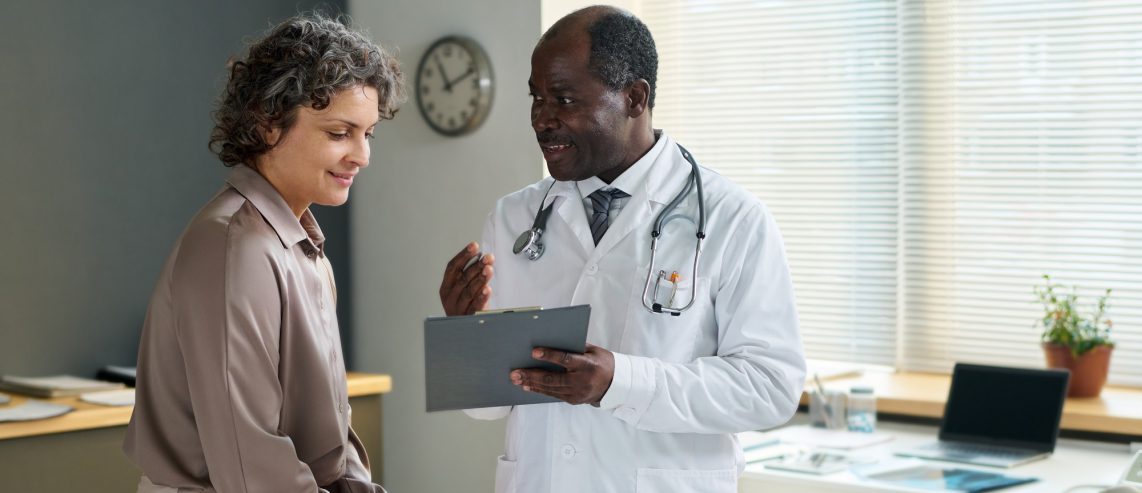Endoscopy and colonoscopy are minimally invasive procedures that examine the digestive tract. They are safe and effective ways to diagnose and treat upper and lower GI tract conditions. You may have questions if your doctor has ordered one or both of these tests.
Here’s an overview of endoscopy versus colonoscopy and what happens before, during, and after each procedure.
Reasons for Endoscopy and Colonoscopy
Endoscopy is a procedure in which a gastroenterologist views your digestive tract with an endoscope, a lighted, flexible tube with a camera. The tube also has special tools to treat problems in your digestive tract. For example, it can remove a polyp or piece of tissue for a biopsy or cauterize a blood vessel to stop bleeding.
There are two types of endoscopy: upper endoscopy, also called esophagogastroduodenoscopy (EGD), and colonoscopy.
During an upper endoscopy, the gastroenterologist inserts the endoscope into your mouth and down your throat to examine your:
- Throat.
- Esophagus (the tube that connects your mouth to your stomach).
- Stomach.
- Upper part of the small intestine.
For a colonoscopy, the doctor inserts the tube, called a colonoscope, into your anus and rectum to examine your:
- Rectum.
- Entire colon (large intestine).
Using endoscopy and colonoscopy, doctors can help prevent, detect, diagnose, and sometimes treat these and other conditions:
- Bleeding.
- Cancer.
- Celiac disease.
- GERD (gastroesophageal reflux disease).
- Inflammatory bowel disease.
- Precancerous colon polyps.
- Stricture (an abnormal narrowing of your esophagus or intestines).
- An ulcer in your stomach.
- Unexplained pain in your stomach or abdomen.
Never Miss a Beat!
Subscribe to Our HealthBeat Newsletter!
Thank you for subscribing!
You can now select the specific newsletters you'd like to receive.
You are already subscribed.
Subscribe to more newsletters in our email preference center.
Sorry, an error occurred. Please try again later.
Get Healthy Tips Sent to Your Phone!
What Happens During an Endoscopy?
An upper endoscopy usually takes less than 30 minutes. During the procedure, you’ll lie on your back or side. Your health care provider may:
- Attach sensors to monitor your breathing, heart rate, and blood pressure.
- Give you medicine through an IV in your arm to help you relax. You may fall asleep during the procedure.
- Spray your throat with a numbing spray so you won’t feel the tube in your throat.
- Insert the endoscope into your mouth and down your throat. They may ask you to swallow to help move the endoscope, but this shouldn’t hurt. During the endoscopy, you can breathe normally but can’t talk.
- Use the endoscope to examine, remove tissue samples, or treat areas in your esophagus, stomach, or small intestine.
Your doctor will remove the endoscope as soon as they finish the test or treatment. Afterward, you’ll wait in the recovery room until your sedative wears off. You may have a mild sore throat from the tube or some nausea, but these will improve over time.
Make sure you arrange for someone to pick you up because the sedative makes driving unsafe for about 24 hours. You can do most regular activities but may still feel groggy until the next day.
Ask your doctor when you can expect your endoscopy results. They may discuss them immediately after the procedure or later at an office appointment. However, if they removed tissue samples to send to a lab for further testing, those results may take longer.
What to Expect During a Colonoscopy
A colonoscopy is also reasonably quick, often taking 30 to 60 minutes. Most people fall asleep and don’t feel or remember anything about their colonoscopy.
For a colonoscopy, your health care provider will:
- Attach sensors to monitor your heart, blood pressure, and breathing.
- Position you on your side with your knees pulled up toward your chest.
- Give you a sedative or other medicine through an IV to make you fall asleep.
- Insert the colonoscopy camera and tube into your rectum. The doctor will slowly advance the camera through your entire colon to examine the lining for polyps or anything abnormal. As it moves, the colonoscope inflates your large intestine with air so the doctor has a better view.
- Remove any polyps or tissue samples for testing using special tools located at the end of the colonoscope. You won’t feel this.
When finished, your doctor will remove the colonoscope, and you’ll go to the recovery room until you wake up. You may feel bloated or gassy for about an hour from the air used to inflate your colon.
As with an upper endoscopy, you’ll need someone to pick you up afterward because the sedative makes driving unsafe.
Your health care provider may tell you the results immediately if your colonoscopy was for colon cancer screening and they were normal. But if they removed polyps or tissue to biopsy, those will go to a lab, and the results will take longer. Ask your doctor when you can expect your results and how they will report them to you.
Preparing for Endoscopy vs. Colonoscopy
You must prepare for each of these tests differently; following your doctor’s instructions is essential. They may have to reschedule the procedure if you don’t prepare correctly.
Endoscopy prep
Having an empty stomach before having an upper endoscopy is vital. Generally, to prepare, you should:
- Stop eating solid foods up to eight hours before your test. You can have clear liquids, like plain coffee or tea, sports drinks, apple juice, or plain gelatin.
- Stop drinking all liquids, including water, four hours before your procedure.
Colonoscopy prep
For a colonoscopy, you must clear everything out of your colon. If there’s any stool, the doctor can’t pass the colonoscopy camera into your colon. Your health care provider will give you written instructions, but generally, before a colonoscopy:
- You may need to eat a low-fiber diet several days before, avoiding most fresh fruits, vegetables, beans, nuts, seeds, and whole grains.
- At least one day before your colonoscopy, you should follow a clear liquid diet. Clear liquids don’t have any solids, pulp, milk, or cream. Your doctor may also ask you to avoid red and purple drinks, gelatins, or popsicles.
- You’ll do a bowel prep to clear out anything remaining in your colon the evening before and the morning of your test. The prep causes diarrhea — but without painful cramps. It’s unpleasant, but completing this step is essential so your doctor can see your colon lining clearly.
Endoscopy and colonoscopy are often the most effective ways to screen for, diagnose, and treat digestive tract conditions. Although they may feel overwhelming, most people find them surprisingly fast and easy. Make sure you ask your health care provider if you have questions or concerns about any part of these procedures.
Sources
About UPMC
Headquartered in Pittsburgh, UPMC is a world-renowned health care provider and insurer. We operate 40 hospitals and 800 doctors’ offices and outpatient centers, with locations throughout Pennsylvania, Maryland, New York, West Virginia, and internationally. We employ 4,900 physicians, and we are leaders in clinical care, groundbreaking research, and treatment breakthroughs. U.S. News & World Report consistently ranks UPMC Presbyterian Shadyside as one of the nation’s best hospitals in many specialties and ranks UPMC Children’s Hospital of Pittsburgh on its Honor Roll of America’s Best Children’s Hospitals. We are dedicated to providing Life Changing Medicine to our communities.

